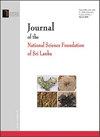斯里兰卡西部和西南海岸海面浮游植物组合和物理化学参数的初步研究
IF 0.4
4区 综合性期刊
Q4 MULTIDISCIPLINARY SCIENCES
Journal of the National Science Foundation of Sri Lanka
Pub Date : 2023-06-30
DOI:10.4038/jnsfsr.v51i2.10780
引用次数: 0
摘要
本研究评估了斯里兰卡西部和西南部沿海水域浮游植物群落结构与理化性质的关系。2017年3月至4月,在科伦坡、贝鲁瓦拉和米里萨的三条近海样线采集浮游植物和水样,每条样线包含10个采样点。每个样线上采样站之间的距离约为2公里。浮游植物样本是通过垂直拖拽从已知深度(2.5米)用网(10µm网眼)收集的,并保存在Lugol的溶液中。浮游植物被鉴定到尽可能低的分类水平,并使用光学显微镜在Sedgwick rafter细胞下计数。使用Ruttner采样器在0.5m深度采集水样,并分析叶绿素a、营养物质和总悬浮固体(TSS)。这项研究确定了57种浮游植物,包括硅藻(33种)、甲藻(23种)和蓝藻(1种)。总体而言,在三个样带中,浮游植物丰度和物种多样性向近海方向下降。浮游植物和硅藻的总丰度在三个样线之间差异显著,据报道,Mirissa和Colombo的丰度明显高于Beruwala(单向方差分析;p<0.05)。浮游植物总丰度与甲藻、甲藻有毒物种、叶绿素a,本研究报道了10种甲藻毒素。硅藻在研究区域占主导地位(60%),其次是蓝藻(31%)和甲藻(9%)。Cerataulina sp.(31%)和Navicula sp.(50%)的硅藻分别在Colombo和Mirissa占优势,而Trichodesmium sp.(85%)的蓝藻在Beruwala占主导地位,这表明当环境条件有利时,该物种可能在研究地点开花。本文章由计算机程序翻译,如有差异,请以英文原文为准。
Preliminary study on surface phytoplankton assemblages and physicochemical parameters, off the west and south-west coasts of Sri Lanka
This study evaluates the phytoplankton community structure in relation to physicochemical properties in the western and southwestern coastal waters of Sri Lanka. Phytoplankton and water samples were collected from March to April, 2017 at three transect lines towards offshore in Colombo, Beruwala, and Mirissa, each containing 10 sampling sites. The distance between sampling stations on each transect line was approximately 2 km. Phytoplankton samples were collected towing a net (10 µm mesh) by vertical hauls from known depth (2.5 m) and preserved in Lugol’s solution. The phytoplankton were identified to the lowest possible taxonomic level and counted under the Sedgwick rafter cell using a light microscope. Water samples were collected at 0.5 m depth using the Ruttner Sampler and analysed for chlorophyll-a, nutrients, and total suspended solids (TSS). This study identified 57 phytoplankton species comprised of diatoms (33 species), dinoflagellates (23 species), and cyanobacteria (1 species). In general, phytoplankton abundance and species diversity decreased towards offshore in the three transects. Total phytoplankton and diatom abundances varied significantly among the three transect lines, and significantly higher abundance was reported at Mirissa and Colombo than at Beruwala (One-way ANOVA; p < 0.05). Total phytoplankton abundance significantly correlated with dinoflagellates, toxic species of dinoflagellates, chlorophyll-a, and nitrate-N (p < 0.01). Ten toxic species of dinoflagellates were reported in the study. Diatoms dominated (60%) in the study area, followed by cyanobacteria (31%) and dinoflagellates (9%). Diatoms of Cerataulina sp. (31%) and Navicula sp. (50%) were dominant in Colombo and Mirissa respectively, while cyanobacteria of Trichodesmium sp. (85%) dominated in Beruwala, indicating the possibility of blooms of this species at study sites when environmental conditions are favourable.
求助全文
通过发布文献求助,成功后即可免费获取论文全文。
去求助
来源期刊

Journal of the National Science Foundation of Sri Lanka
MULTIDISCIPLINARY SCIENCES-
CiteScore
0.90
自引率
0.00%
发文量
57
审稿时长
>12 weeks
期刊介绍:
The Journal of National Science Foundation of Sri Lanka (JNSF) publishes the results of research in Science and Technology. The journal is released four times a year, in March, June, September and December. This journal contains Research Articles, Reviews, Research Communications and Correspondences.
Manuscripts submitted to the journal are accepted on the understanding that they will be reviewed prior to acceptance and that they have not been submitted for publication elsewhere.
 求助内容:
求助内容: 应助结果提醒方式:
应助结果提醒方式:


